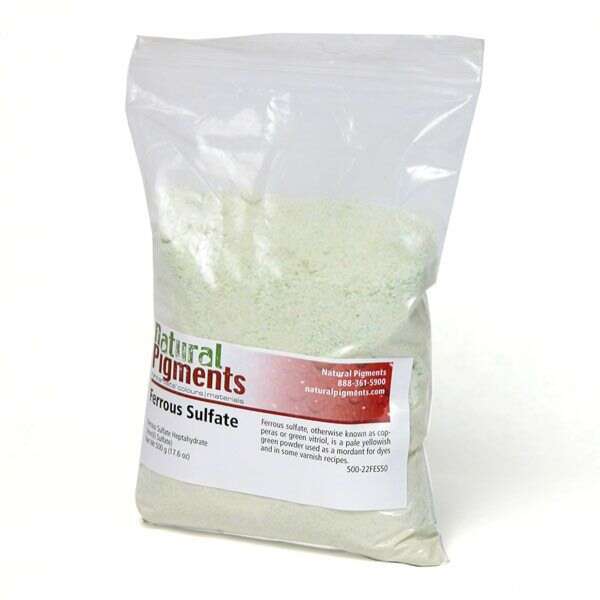Ferrous Sulfate
A mordant for varying the sea-green colors of pigments and iron gall ink. Learn more.
Ferrous Sulfate, or iron(II) sulfate, is most commonly encountered as the blue-green heptahydrate, known since ancient times as copperas or green vitriol. Ferrous sulfate can be found in various hydration states, and several forms exist naturally. At 90° C., the heptahydrate form loses water to form the colorless monohydrate.
Ferrous sulfate was used to manufacture inks, most notably iron gall ink, from the Middle Ages until the end of the 18th century. The ink was generally prepared by adding ferrous sulfate to a solution of gallotannic acid. The tannic acid was usually extracted from oak galls (also known as "oak apples" or, more correctly, "oak marble galls") or galls of other trees; hence the name. Fermentation or hydrolysis of the extract releases gallic acid, which yields a darker black ink. The fermented extract is combined with the ferrous sulfate and a binder such as gum arabic.
Ferrous sulfate heptahydrate is generally the starting point in preparing iron pigments. When pure, it forms fine sea-green crystals with an astringent, metallic taste that is not poisonous and easily soluble in water. After prolonged exposure to the air, ferrous sulfate becomes covered with an ocher-colored crust consisting of basic ferric sulfate. The ferrous oxide contained in the green vitriol has united with oxygen and been converted into ferric oxide. The latter requires more acid than ferrous oxide to form soluble salts to separate an insoluble basic salt. The same happens when a ferrous sulfate solution is exposed to the air. When green vitriol, or any other ferrous salt, is exposed to the action of oxidizing agents, such as chlorine or nitric acid, the iron is rapidly changed into the ferric state. This transformation is of particular importance in the manufacture of certain blue pigments.
It is also found to be used in dyeing as a mordant. Two different methods for the direct application of indigo dye were developed in England in the 18th century and remained in use well into the 19th century. One of these, China blue, involved iron(II) sulfate. After printing an insoluble form of indigo onto the fabric, the indigo was reduced to leuco-indigo in a sequence of baths of ferrous sulfate (with reoxidation to indigo in the air between immersions). The china blue process could make sharp designs, but it could not produce the dark hues of other methods.
| Typical Properties | |
| Chemical Name: | Iron(II) Sulfate Heptahydrate |
| Chemical Formula: | FeSO4·7H2O |
| CAS No.: | 7782-63-0 |
| Mesh (%): | 90% 100 mesh |
| Color: | Blue-green crystalline powder |
Storage
Keep it in a tightly closed container in a cool, dry, ventilated area. Protect against physical damage. Maintain a constant temperature exceeding 24° C. (75° F.). Fluctuating temperatures cause product oxidation. Do not use this product if it is coated with brownish-yellow basic ferric sulfate. Isolate from incompatible substances. Containers of this material may be hazardous when empty since they retain product residues (dust, solids); observe all warnings and precautions listed for the product.
Heath and Safety
Do not ingest. Do not breathe dust. Wear protective gloves and clean body-covering clothing. Use chemical safety goggles and a full face shield where splashing is possible. Refer to the Material Safety Data Sheet.
WARNING! HARMFUL IF SWALLOWED OR INHALED. CAUSES IRRITATION TO SKIN, EYES AND RESPIRATORY TRACT. AFFECTS THE LIVER.
Environmental Hazards
The product's short-term and long-term adverse environmental effects are unknown. If it spills, comply with federal, state, and local regulations for reporting spills. For further details, refer to the Material Safety Sheet and labels.
| SKU | 500-22FES |
|---|---|
| Brand | Rublev Colours |
| Vendor | Natural Pigments |
| Processing Time | Usually ships the next business day. |
WARNING! Contains ferrous sulfate. Harmful if swallowed. Causes serious eye irritation. May cause respiratory irritation. Avoid breathing dust. Wear eye protection and gloves. Wash hands thoroughly after handling. Do not eat, drink, or smoke when using this product. Read the SDS for all cautionary statements. Conforms to ASTM D 4236.
Hazard Pictograms
 |  |  |
| GHS07: Exclamation Mark | GHS08: Health Hazard | GHS09: Environmental Hazard |
Signal Word: Warning
Hazard Statements
H302: Harmful if swallowed.
H319: Causes serious eye irritation.
H335: May cause respiratory irritation.
H411: Toxic to aquatic life with long-lasting effects.
Precautionary Statements
P280: Wear protective gloves and eye protection.
P261: Avoid breathing dust.
P264: Wash hands thoroughly after handling.
P270: Do not eat, drink, or smoke when using this product.
P301+P312: IF SWALLOWED: Call a POISON CENTER or doctor if you feel unwell.
P305+P351+P338: IF IN EYES: Rinse cautiously with water for several minutes. Remove contact lenses, if present and easy to do. Continue rinsing.
P304+P340: IF INHALED: Remove person to fresh air and keep comfortable for breathing.
P273: Avoid release to the environment.
P391: Collect spillage.
P501: Dispose of contents/container in accordance with local regulation.



